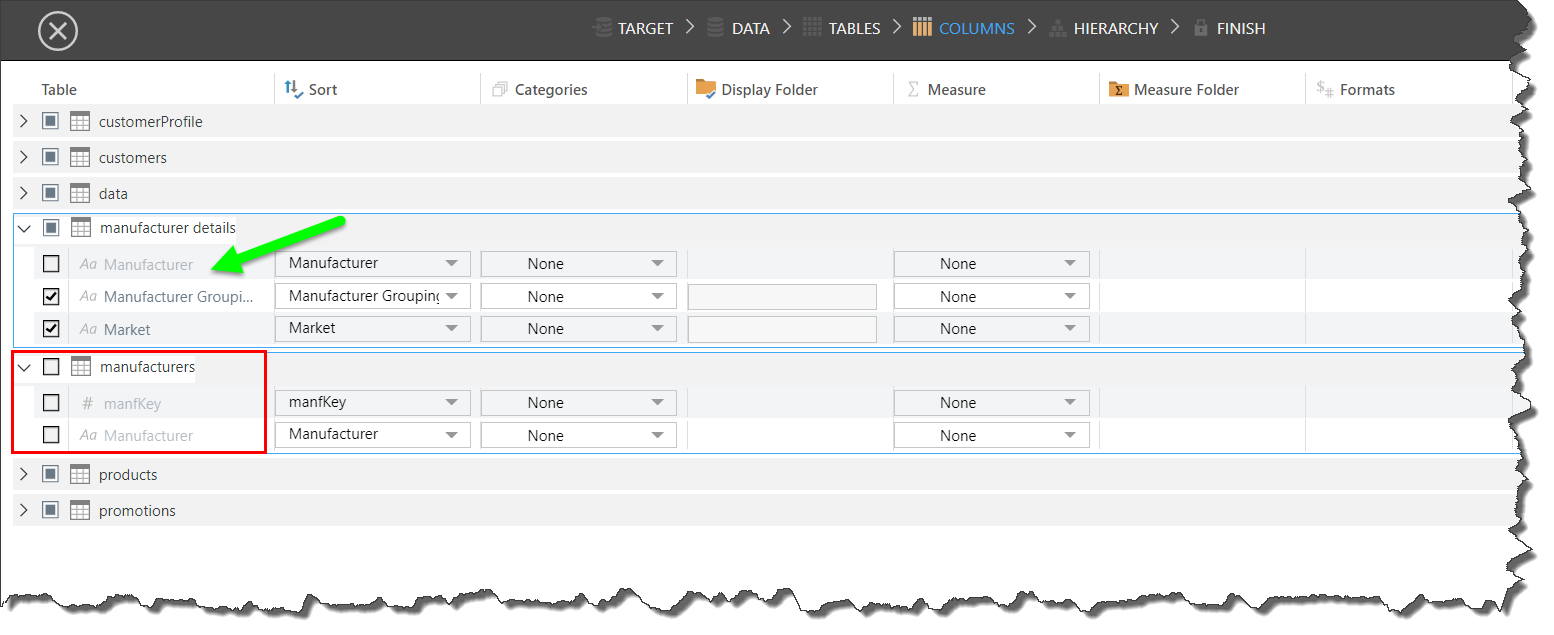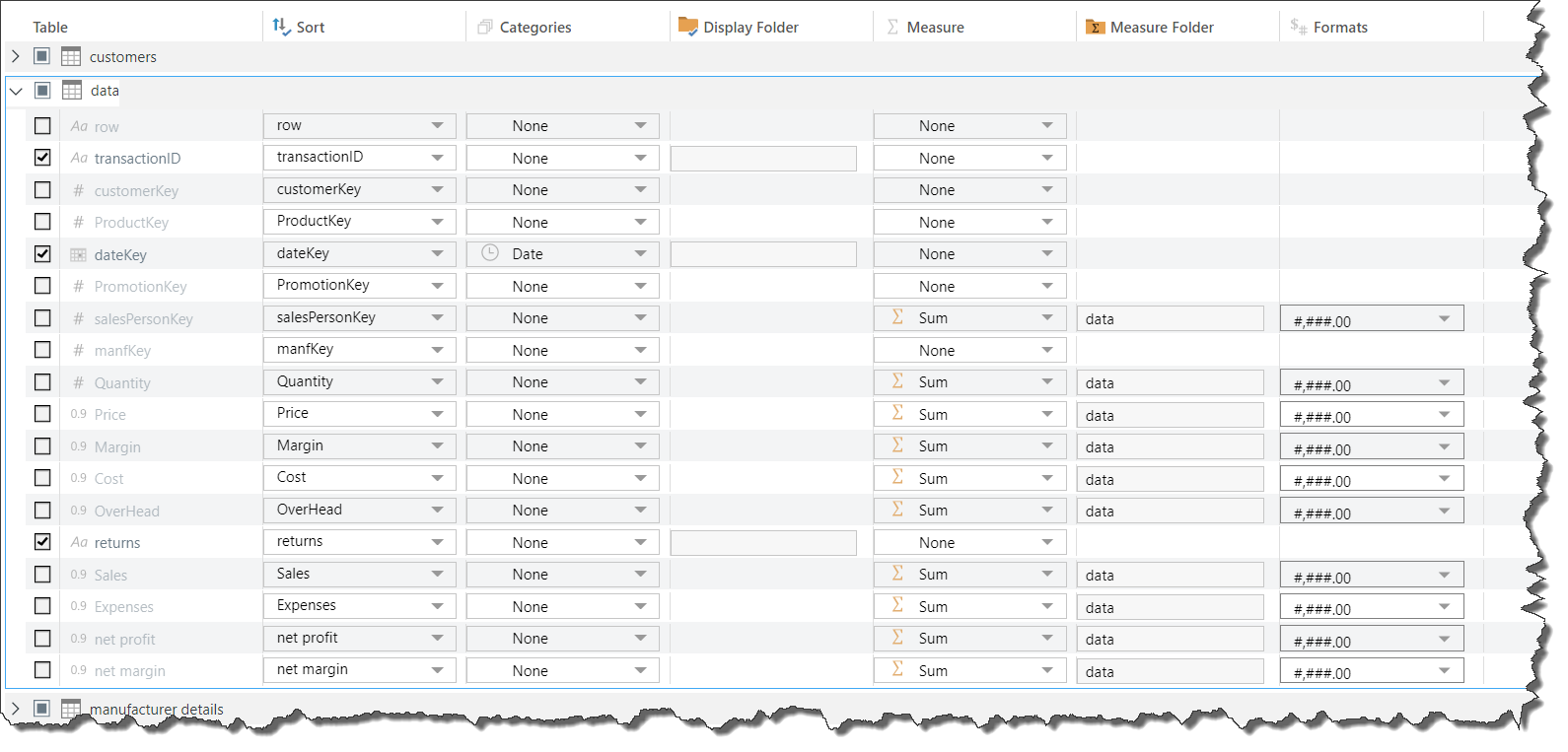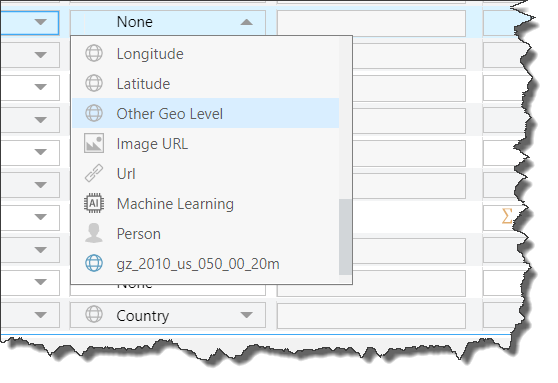Columns
From columns, you can define metadata for columns and measure. Expand the relevant table to view its columns; you can hide or un-hide columns, and edit the metadata for columns as needed.
Visibility
Visibility determines which tables and columns will be visible in the data model. Pyramid automatically hides key columns, so they will not be visible in the data model unless you un-hide them.

Pyramid also uses heuristics to hide measures, and to assign them to a measure aggregation. This means that the won't be visible as column's in the data model, but them will be visible as measures. If you un-hide a measure, it will be visible as both a column and a measure in the data model.
Column Metadata
Expand each table to see a list of its columns. You can edit the metadata for each column by changing the sort column, or assigning it to a category or a display folder. For measures, you can change the aggregation type, change the measure folder, and change to format.

Sort
By default, each column is sorted by itself. You can sort a column by a different column within the same table by selecting the sort column from the drop-down list.
Categories
Categories are used to assign a column to a specific 'type', such as date-time, geospatial, or machine learning. Assigning the column to the appropriate category is crucial in enabling the functionality for that category when building queries.

For instance, assigning the Country column to the Country category allows users to create map visuals with the Country column in Discover.
Pyramid uses heuristics to categorize columns, but you can make changes if required.
There are several types of categories:
- Date-Time: assign date-time columns to the appropriate date-time category. For instance, a Year column should be assigned to the Year category. This enables date-time functionality, such as building the formulations in the Time calculation Wizard in Discover.
- Geospatial: geospatial columns must be assigned to the correct geospatial category to enable map visuals in Discover.
- Image URL: if a column contains URL links to images, assign it to the Image URL category so that the images will be rendered when the column is added to a visual.
- URL: a column containing URLs can be assigned to the URL category so that when the column is added to a visual, each URL will be represented by a link icon. Clicking the link will open the URL, without the need for any additional configuration.
- Machine Learning: any columns generated by machine learning algorithms should be assigned to the machine learning category.
- Person: assign a column to the Person category to enable the column for natural language query (NLQ) use. This means users can enter NLQ phrases such as "Sales by Team Member".
- Custom Maps: custom map files that have been imported will appear in blue at the bottom of the drop down, with a blue globe icon. Any geospatial columns that will be used to visual custom maps should be assigned to the appropriate custom map category. Click here to learn more about configuring custom maps.
Display Folder
You can organize columns into display folders by entering a folder name in the Display Folder field. While measures and hierarchies are automatically sorted into folders, other columns are not. Defining folders can be a useful was of organizing the columns in larger tables.
Measure
Set the aggregation for a measure from the Measure drop-down. Pyramid uses heuristics to automatically assign numeric decimal columns as measures, and assigns them to the Sum aggregation by default. Change the aggregation type as required.

If you want to set multiple aggregation types for a single measure, choose 'Add Multiple Measures' (green highlight above) and add the required measure aggregations in the Multi Measures panel. This allows you to look at a measure column from several vantage points. For instance, you may want to see sales aggregated not only by sum, but also by count and distinct count.
Measure Folder
Using heuristics, Pyramid organizes your measures into measure folders. You can create new folders, or change folder names, simply by entering the required folder name in the Measure Folder field; write the folder name in this field for every measure that should be placed in that folder.
Formats
Measures are assigned a default format of #,###.00. You can change the formatting for a measure by selecting the require format from the drop-down. You can also use a custom format by entering it into the Formats field.